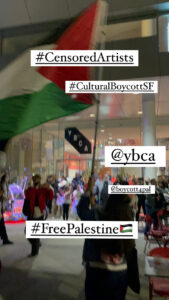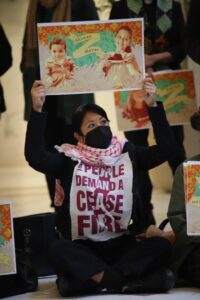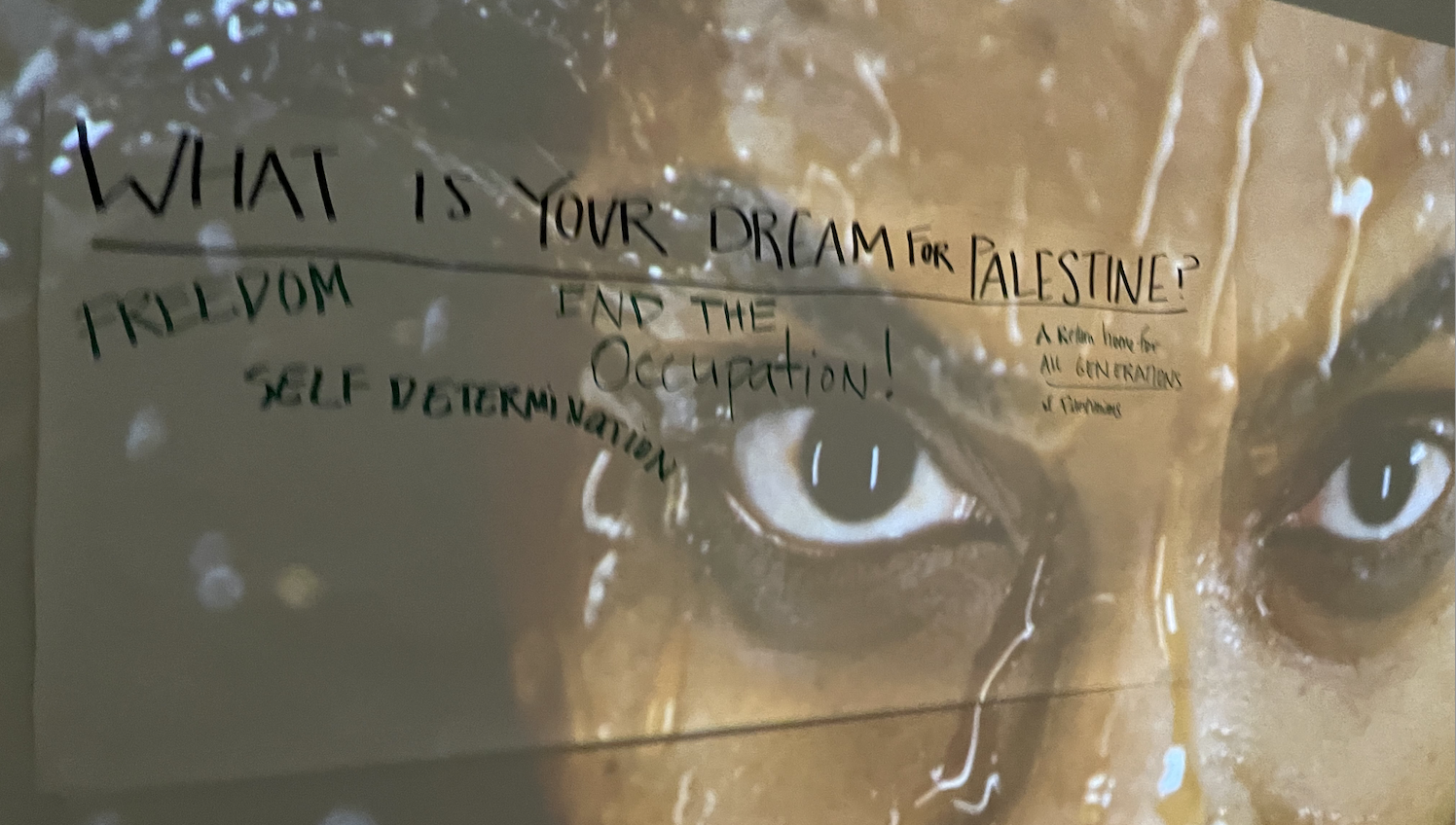Art installation by Courtney Desiree Morris
[ID: Altered video art installation by BAN 9 Artist, Courtney Desiree Morris. The face of a woman of African descent is covered in honey. Words on paper over it read “What is your dream for Palestine?” Written answers include “Self determination,” “End the Occupation.” and “Freedom.”]
As the horrors of the ongoing U.S. funded Israeli genocide in Palestine pour into our social media feeds from Gaza over the last six months, it has become more clear to me how FLACC’s seemingly small, yet, public “platform” has more influence and power on a political and cultural stage than I realized. Not because we have a million followers, but because you don’t have to be that big in order for the algorithms to stifle you on Facebook and Instagram. The recent congressional efforts to ban TikTok, the Twitter files report by Matt Taibbi last year, the removals and demonetizing of people-funded YouTube accounts, the ongoing silencing and firing of scholars and journalists across the country is evidence that our knowledge challenges the political narrative of which they are no longer in control. Our government and its donors are worried about dissenting voices of artists, educators and regular people exercising our 1st Amendment rights to freedom of speech—which includes sharing the raw footage of the bloody crimes against humanity in Gaza.
FLACC Censored by Meta
Festival of Latin American Contemporary Choreographers (FLACC) had under 2,000 followers on Instagram when the Meta Corporation permanently deleted the @flaccdanza Instagram page and by extension disabled access to all three of my Facebook pages connected to my name. It happened on my birthday, October 19, days after I attended a pro-Palestine march in San Francisco which I posted about on my personal IG account on October 14, 2023. It also happened when I was getting the most social media traffic during the 10th Anniversary celebrations of FLACC when we were purchasing a bunch of ads, boosting posts and following a lot of new accounts, including Palestinian accounts, to get the word out about our Latinx dance festival while simultaneously staying engaged and in solidarity with the people suffering in Palestine.

[ID: Boubion’s Instagram story after the BAN 9 protest on February 15, 2024. Photo of the crowd outside YBCA after “Love Letter to Gaza” art intervention with hashtag text: #CensoredArtists, #CulturalBoycottSF, #FreePalestine, and tags for @ybca and @boycott4pal]
Between October and November 2023, Human Rights Watch documented over 1,050 takedowns and other suppression of content on Instagram and Facebook that had been posted by Palestinians and their supporters. After giving FLACC’s dance festival ads three totally different warnings for violating “community guidelines,” we concluded that Meta’s politically manipulated algorithms had targeted us. Note to all: Make sure you have back up admins on Facebook! I still have a personal IG and we did make a new @flaccdanza_ account, but only FLACC’s Marketing manager, Marivel Mendoza, has access to FLACC on Facebook as an administrator. We both also had our WhatsApp accounts suspended on the same day during our festival in late October, but gained them back several months later, without an explanation from Meta.
To continue leveraging our public platform, one of FLACC’s solidarity efforts as a Latinx and Indigenous arts organization has included sending monthly newsletters to our subscribers promoting the Palestinian Campaign for Academic and Cultural Boycott of Israel (PACBI). The campaign, created in 2004, was inspired by tactics for successfully ending the South African apartheid regime through the power of boycott, divestment and sanction (BDS) efforts. Similarly, the liberation of Palestine will require the rest of the world to stop supporting any entity (including art and entertainment) that is funded by, aligned with or supportive of Israel’s terrorism. The boycott is aimed against the state of Israel, not against individual Israeli artists, or against Jewish artists, but against any artist or academic who supports the apartheid state of Israel and its imperialist policies against Palestine.
Solidarity
I wanted to write this article for In Dance to encourage more dance readers to use their own platforms to take a stand and to highlight a few local dance artists in the SF Bay Area who are tirelessly working against oppression by using their personal and professional resources in solidarity with Palestine. I gathered statements and material from local dancers Leila Mire, Cookie Harrist, Tessa Nebrida, José Navarrete and Leyya Tawil. They are among hundreds of artists in the bay area who are uncompromising towards Israel’s displacing, starving and bombing over half the Gazan population for the last six months with U.S. weaponry. Our efforts, and yours, ultimately gain strength when we are principled and united for a cause against the illegal occupation of Palestine which forces every U.S. taxpayer into sharing responsibility for this genocide in Gaza.
To build a coalition implies that we are all connected to the suffering in Palestine—as we are all connected to the western capitalist agendas in Cuba, Chile, Venezuela, Haiti, Syria, Yemen, Congo, Sudan, Ethiopia and many other countries both historically and currently. Solidarity can range from simple awareness-building by raising the algorithms through reposting, liking or following Palestinian journalism, to signing petitions and calling elected officials, encouraging faith leaders to get involved, donating relief funds for Gazans, creating public art interventions, engaging in direct action protests, risking arrest and much more.
In early December 2023, I attended a teach-in at Bandaloop studios in Oakland by Lebanese-American researcher, dancer, scholar, writer and activist, Leila Mire. Leila is a UC Berkeley PhD Performance Studies candidate who has been speaking out about how Israel and the U.S. use dance as a form of “soft power” in an attempt to normalize the Israeli occupation of Palestine and to artwash the cultural image of Israel. In an article she wrote for thINKingDANCE in 2021, Leila writes: “As artists, our priority should be shifting narratives to resist oppressive regimes. Art is incomplete when the voices and embodied knowledge of indigenous voices are silenced. The world is listening to Palestinians, and it is time the dance community does the same.” If arts organizations and funders are aligned with indigenous rights movements and decolonization efforts, this principle should extend to Palestine.
Normalization
In a world where the corporate media headlines continue to mislabel the current onslaught a “war” as if there are two equal sides responsible for the indiscriminate carpet bombings, imprisonments and starvation of Gazans, it is important that we understand the colonial settler interest of the west and the history of the asymmetric power dynamic via the state of Israel and the people of Palestine. With the two pro-Israel talking points on repeat: “Israel has a right to defend itself” and “Hamas is a terrorist organization” it is also important as artists that we don’t engage in activities of normalization that emphasize “co-existence” rather than “co-resistance,” or worse, conflate more dangerous messaging that being against this genocide is equal to being antisemitic. Whether there is a two state or a one state solution, Palestinians of all faiths must have the right to self determination and sovereignty over their land and lives. I recommend watching the documentary “Israelism” to get a clear perspective on the colonial indoctrination of a nationalist Jewish identity.
The soft power tactics of “Normalization” in the Palestinian context is particularly relevant to artists, academics and cultural workers as it refers to any activity that creates the impression of false equivalency that Palestinians, the oppressed, and Israel, the oppressor, are both equally responsible for “the conflict.” As defined by the PACBI website, an example of a boycottable normalization project is “a joint event that is designed explicitly to bring together Palestinians/Arabs and Israelis so they can present their respective narratives or perspectives, or to work toward reconciliation without addressing the root causes of injustice. However, a joint project is not boycottable if: (a) the Israeli party in the project recognizes the comprehensive Palestinian rights under international law (corresponding to the 3 rights in the BDS call); and (b) the project/activity is one of ‘co-resistance’ to oppression rather than ‘co-existence’ under oppression.”

[ID: Filipina dancer Tessa Nebrida during a sit-in at Senator Alex Padilla’s office last December demanding for a ceasefire. Her hair is black and pulled back, and she wears a N95 mask and a red and white Kaffiyeh around her neck. Her shirt reads: “The People Demand a Ceasefire.” She holds a poster above her head with the images of two children.]
The co-resistance teach-in at Bandaloop was organized by dancer, ally and activist Cookie Harrist, who started the “Dance Action Group” to mobilize dancers from all backgrounds, and strengthen our community’s presence at protests and direct actions. The group currently has about 50 Bay Area dancers directly involved on signal and is open to vetted artivists interested in staying informed and taking direct action for Palestine now and for other causes in the future.
“The Dance Action Group serves to inform dancers of upcoming actions (via signal and in person) so we can use a buddy system for safety, deepen our relationships to each other as we take action together, and strengthen our organizing capacity as a community.
While artists making work addressing the genocide of Palestinians is of course an important tactic in resistance efforts, I am personally investing in the tactic of taking existing community networks and repurposing them to increase the organizing capacity of a broader collective.
But I do believe if we decide art-making is our primary tactic, we must take our work out of the theater and into the streets, to the doorsteps of complicit representatives, lobbyists, and weapons manufacturers that live right here in the Bay Area.” -Cookie Harrist
Bay Area Now 9 Artists at YBCA
On February 15, I was invited by dancer Tessa Nebrida to join about 50 other activists and co-resistant organizations to help the Bay Area Now 9 artists at Yerba Buena Center for the Arts intervene on their own artwork in their renamed exhibit “Love Letters for Gaza” after being censored by the YBCA program, “Love Letters for Soma.” We assisted 8 of the artists in altering their work with pro-Palestinian symbolism and messaging as an interventionist response targeting staff, funders and board members of YBCA. Following the protest, YBCA chose to further silence the artists by closing the exhibit for four weeks. The action precipitated a public hearing called by Supervisor Hillary Ronan of District 9 who strongly supported the BAN 9 artists, all of whom are people of color. A petition created by 15 YBCA employees rallied for the BAN 9 exhibit to reopen and was finally successful after four weeks of pressure from over 500 artists and community members. I asked Tessa, a Filipina dance artist who engages in decolonial art practices and has supported the Palestinian solidarity struggle for years, to lend her thoughts about the role of the artist during this time.
“I’m reminded of something Chicago-based filmmaker Merawi Gerima said: ‘In the face of genocide, when civilians are being massacred by the most powerful white supremacists on the planet, the role of the artist is like everybody else. The role is to get involved because genocide is literally a global priority, and it requires the full attention of all of humanity using all of its abilities to the maximum including art.’ It’s such a critical time of collectivizing our efforts and also doing the necessary inner work as individuals to examine the parts of ourselves with the most proximity to power. The fact that many Bay Area dance institutions, organizations, companies and artists continue to remain silent and disengaged speaks volumes to the ways in which our art form is still rooted and dependent on Zionist funding in order to survive.”
– Tessa Nebrida
In solidarity with the BAN 9 artists who now call themselves Bay Area Artists Against Genocide (B.A.A.A.G), the artists and curators of the Fresh Festival also took collective action and canceled their events at YBCA, rather than finding another location to perform. After they canceled, I reached out to José Navarrete (aka José Ome Mazatl) Mexican-American FLACC contributor, co-director of NAKA Dance Theater and co-curator of the Fresh Festival. In his letter to the artists and staff at YBCA he stated:
“An artist’s responsibility is to reflect on the political and social conditions in which we live, and it is our responsibility as human beings to take action when we see innocent people being exterminated by colonialism, western imperialism and white supremacy. YBCA claims to be ‘a catalyst of creative exploration, expression and innovation that empowers artists, inspires community and drives lasting social change,’ but unfortunately, YBCA’s actions are in direct contradiction to these values.” – José Ome Mazatl
José not only wrote a letter of solidarity but he also asked Arnoldo Garcia to curate RAZA CON GAZA at the Eastside Arts Alliance in Oakland. The event included Latinx poets, musicians and dancers who came together for two days of art-in-solidarity, including: AntiFaSon, Camellia Boutros, Diana Gameros, Leticia García, Lubna Morrar, Madeleine Zayas, Mabel Valdevizio, Cristina Lopez Suarez, Agustina Amiconi and more.
Palestinian Resilience
Finally, I reached out to Leyya Tawil, a Syrian, Palestinian, American who is an artist, a curator, and a cultural activist working in sound and dance. Leyya has been steeped in the San Francisco and Detroit dance and music scenes since 1997 while touring her work in the U.S., Europe, Russia and the Arab world. Her futurist aesthetic holds a profound sense of resilience in the unimaginable dystopia of our present world. Check out Leyya’s public art intervention four years ago, Turku Future Folk Dance. Leyya is the founding director of Arab.AMP, a platform for futurist live art and ideas from the SWANA diaspora and their allied communities. Her curatorial practices can be seen at Southern Exposure (SF), Arab American National Museum (Dearborn, MI), and she is also the co-founder of TAC Temescal Art Center (Oakland).
Leyya Tawil: “There is an ethnic cleansing over 100 years in rollout. Solidarity actions and interventions are a crucial part of strengthening our global majority. I am grateful and emboldened by the “Dancers for Palestine” and related coalitions – they have mobilized throughout the US in order to call artistic, cultural, and academic institutions to account for their complicity – and to turn towards justice, and make PACBI and BDS commitments a loud and real priority. In this, we are together.”
This article appeared in the Spring 2024 issue of In Dance.


